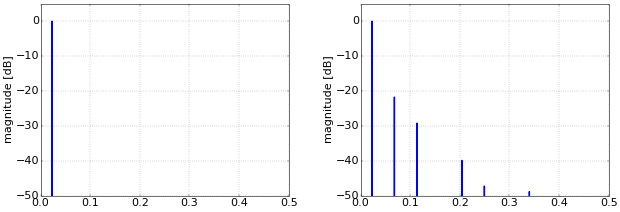Before you can digitally process an analog (i.e., real-world) signal, you have to convert it to a digital form by sampling it. Sampling an analog signal is typically done with an A/D (analog-to-digital) converter. A very important aspect of this conversion is that you should avoid clipping the original signal. Clipping happens when the level (or voltage) of the analog signal exceeds the range of the A/D converter. Let’s take an example converter with a range of −5 to +5 V.
Example
As an illustration, I’ll use a typical run-of the-mill sine wave, as shown in Figure 1.
 Figure 1. Correctly sampled sine.
Figure 1. Correctly sampled sine.This sine is correctly sampled, which means that the complete waveform is captured, including the lowest and highest values. Given the range of the example converter, this sine might have a range of ±3 V, or any range ≤ ±5 V.
Figure 2 shows the same sine, but with a higher input level, so that the the A/D converter reaches its peak level when the sine is only at 80 percent of its maximum amplitude. This would happen with a sine of range ±6.25 V. The effect is that the top and the bottom of the sine is cut off. Of course, the A/D converter still returns a value for those samples, and it can’t do better than simply always returning the maximum or minimum voltage.
 Figure 2. Clipped sine.
Figure 2. Clipped sine.This kind of distortion of the signal is highly undesirable, since it is typically very difficult or impossible to remove again.
Frequency Space
In frequency space, the effect of clipping is that there are all sorts of extra peaks in the spectrum.
 Figure 3. Spectra of sine (left) and clipped sine (right).
Figure 3. Spectra of sine (left) and clipped sine (right).The spectrum on the left shows the classical (one-sided) spectrum of a sine wave, which is a single peak. One simple application of this spectrum is determining the frequency of the sine. The spectrum on the right shows the spectrum of the clipped sine. The effect of the clipping is clearly not subtle. If you know that the signal contains only a single frequency, then this might be manageable. However, in practice there’ll be all sorts of frequencies present, with different amplitudes, and it will no longer be possible to determine which ones are truly from the input signal and which ones are the result of clipping.
So clipping should be avoided at all costs. Luckily, it is easy to detect, because a correctly sampled signal should have hardly any samples that have the minimum or maximum value. These samples are likely to be clipped, or it will at least be difficult to be sure that they are not. A possible exception to this rule is a signal with lots of noise. In that case, it might not be realistic to demand close to zero samples with the extreme values, since that might cause loss of resolution. The acceptable amount of clipping then becomes a design tradeoff.
Audio Example
I’ll wrap up this article with an audio clip, to make the subject a bit more tangible. The clip starts with a one second correctly sampled sine. Then there is a small pause, followed by a one second clipped sine (at 80 %, like the above example). I’ll think that you’ll agree with me that the effect of the clipping is clearly audible.
Correctly Sampled and Clipped Sine at 1000 Hz
Add new comment